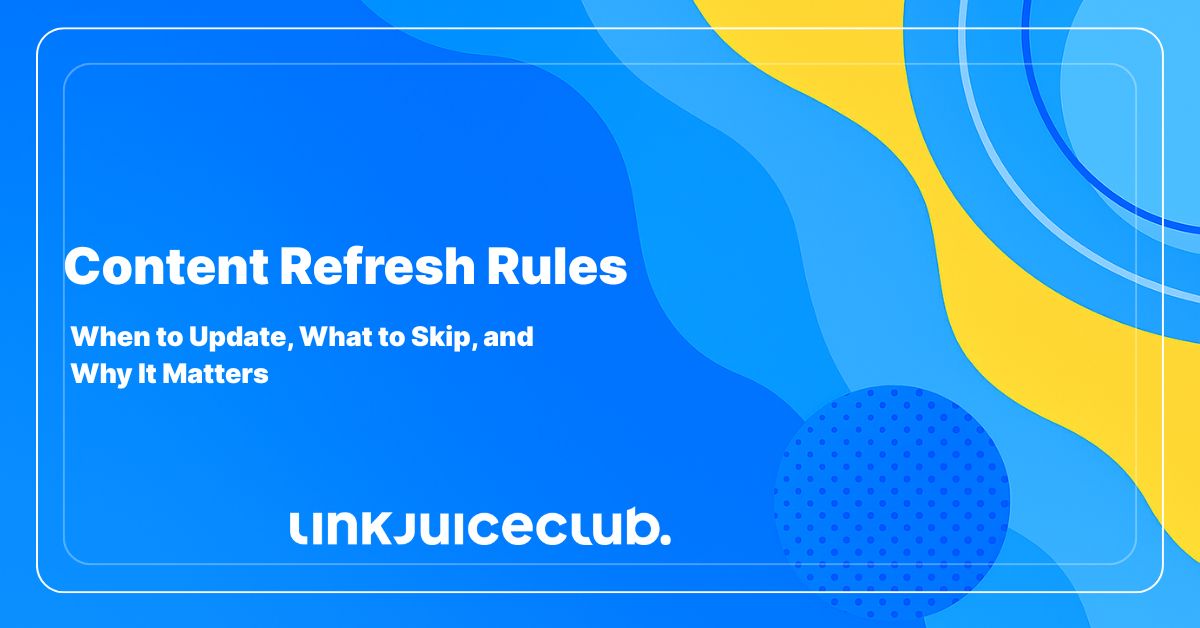
Content Refresh Rules: When to Update, What to Skip, and Why It Matters
Everyone loves to talk about “evergreen content.” The kind of post you write once, let it marinate, and watch it rank forever.
Except… that’s not how it works anymore.
We dug into thousands of SERPs and found something eye-opening: the average page-one content for competitive keywords had been refreshed within the last two years. So much for the “set it and forget it” approach.
As SEOs, we’ve always suspected freshness gives content an edge. At Siege, we’ve preached about lowering your “freshness distance” for years. This time, we brought receipts.
We dissected over 17,000 keywords across multiple industries, analyzed search intent, and pinned down how often different types of content get updated. The goal? Strip away the SEO chatter and figure out what it really takes to keep your content alive.
This guide breaks down what a refresh actually is, when a quick tune-up is enough, which content types demand urgency, and why even “evergreen” posts eventually wither. And yes, you’ll get the hard data to back it all up.
What Counts as a Content Refresh?
A refresh isn’t running spellcheck or fixing a broken link. It’s a facelift, not a band-aid.
Refreshing means updating outdated stats, weaving in new insights, improving readability, and making sure your piece matches today’s search intent and Google’s love language: E-E-A-T.

The goal? Keep your content relevant, valuable, and visible — while boosting link equity that’s already flowing to the page.
Think of it this way: a refresh tells both Google and your audience, “Hey, this isn’t yesterday’s leftovers. It’s today’s special.” That perception shift alone can keep a post competitive for years longer than one left to collect digital dust.
What About a Content Update?
An update is more surgical. Think minor tweaks instead of a full overhaul.
You’re correcting a stat, adding a recent example, or polishing phrasing to match current trends. The backbone of the article stays intact.
It’s the difference between swapping your car’s oil and replacing the engine. Both keep you moving, but one is way less invasive.
Updates shine when your piece is structurally sound but lagging in accuracy. Maybe a stat from 2019 needs replacing or a brand you cited has pivoted. In those cases, an update is all you need to keep the page credible without reinventing the wheel.
Website Layout Updates: The Overlooked Player
Sometimes, it’s not the words that age — it’s the design.
A layout update tackles visuals and structure: redesigning templates, cleaning up navigation, fixing mobile responsiveness, and tightening user experience.
This isn’t just about making your site pretty. A smoother, modern design keeps visitors around longer, improves click-through rates, and signals to search engines that you actually care about user experience.
Think about it: if your blog still looks like it’s running on MySpace, no amount of keyword polish will save it. Layout updates make sure your content refresh looks as good as it reads.
How Often Should You Update Content?
We didn’t want to guess. So, we pulled keyword data from Ahrefs — over 17,000 phrase match keywords spanning popular query types like “best,” “what is,” “how to,” “reviews,” “tips,” and more.
Then we studied how often top-ranking content showed a “last updated” date. On average, the median time since update was about 730 days — two years.
But here’s the kicker: not all keywords are equal. Some content types sprint while others stroll. For high-volume, competitive SERPs, freshness is practically table stakes. For slower-moving queries, you can afford more breathing room.
This study gave us the benchmarks, but your strategy still has to flex depending on search intent, industry trends, and how aggressive your competitors are. In short: two years is the average, not the rule.
High-Frequency Content: Blink and You’re Outdated
Take “best software” keywords. These SERPs move fast — average updates land every 143 days, and in some cases, every week. “Best software for taxes”? At the time we checked, updates were happening every seven days. That’s not evergreen, that’s hyper-seasonal.
Even broader “best” keywords, like “best smart watches,” refresh every 400 days. The product cycle keeps pushing new models into the spotlight, and your content has to keep pace.
If you’re in this space, six-month refreshes should be your baseline. Anything slower, and you’re letting competitors eat your rankings alive. Consider building these refreshes into your editorial calendar the same way you’d plan launches or campaigns — because that’s essentially what they are.
Mid-Frequency Content: The Steady Eddies
Keywords around “rates” — like mortgage rates or loan rates — refresh roughly every 500 days. They move slower than tech, but they still demand regular check-ins.
“Review” queries clock in at about 573 days. “Trends” keywords hover around 410 days. Both categories are fueled by shifting opinions and annual changes, so they’re far from static.
The lesson? If your content depends on comparisons, financial data, or evolving industries, don’t wait two years to update. Annual touch-ups are a safer bet. Think of it as seasonal maintenance: you wouldn’t drive through winter without checking your tires, so why leave reviews or financial guides unchecked for multiple years?
Low-Frequency Content: The Almost-Evergreens
Then there’s the content that holds steady. “What is” and “how to” posts don’t need a facelift every quarter. Their average refresh times push past 800 days.
“Calculator” keywords were even slower — many SERPs didn’t show dates at all, averaging over 1,400 days between updates. Math doesn’t change much, after all.
But don’t get too comfortable. Even evergreen content rots. A quick audit to confirm accuracy and adjust formatting keeps these assets healthy. Remember: evergreen doesn’t mean immortal. Competitors still sneak in, and design or formatting alone can make your page feel dated compared to fresher results.
Why Bother With Refreshes?
Because content decay is sneaky.
Your five-star masterpiece can quietly become yesterday’s news, losing clicks, rankings, and credibility while competitors glide past.

Search engines reward freshness, users demand accuracy, and stale content signals neglect. A refresh isn’t just maintenance — it’s insurance.
It also builds trust. Outdated info frustrates readers. Fresh content shows you’re current, reliable, and worth linking to. And when content earns trust, it gets shared. That ripple effect boosts link equity and visibility without needing a brand-new post.
There’s also efficiency at play. Refreshing an existing piece takes far less time than producing new content from scratch. Think of it as compounding interest: the more you nurture old assets, the more value they pay back over time.
How to Do Content Refresh Without Phoning It In
Let’s get tactical. A refresh isn’t just slapping today’s date on last year’s blog. Here’s how to do it right:
1. Run a Content Audit
Think reconnaissance, not busywork. Use Ahrefs, Google Analytics, or Screaming Frog to inventory your content. Track traffic, rankings, bounce rate, and time on page. Spot what’s losing steam, what’s still thriving, and what’s dead weight.
A good audit doesn’t just tell you what’s underperforming — it helps you categorize pages. Some need small fixes, some need structural overhauls, and some need the digital equivalent of a Viking funeral. This clarity makes the refresh process manageable instead of overwhelming.
2. Replace Outdated Information
Kill stale stats. Update data, examples, and references with current info. Readers trust accuracy, and Google rewards it. Don’t just swap numbers — expand with fresher, stronger insights.
If you’re in a fast-moving industry, this step is where you can leapfrog competitors. Bring in new studies, product launches, or expert quotes. Treat this as your chance to add value beyond “updating” — elevate the piece entirely.
3. Optimize Keywords for Today
Search intent evolves. So should your targeting. Find trending queries, rework meta tags, and weave new terms naturally into your copy. Write for humans first, but keep search engines in the loop.
What ranked in 2021 might not even be phrased the same way today. Tools can help you spot new angles, but your job is to translate them into content that feels fresh and natural.
4. Restructure for Readability
Break up walls of text with headers, bullets, and visuals. Shorter paragraphs = longer attention spans. Think of it as designing a map your readers can actually follow.
This isn’t just about formatting — it’s about UX. If readers bounce because your text feels like a dissertation, rankings suffer. Structure is a refresh tool in its own right.
5. Add New Sections
Expand scope with FAQs, subtopics, or fresh research. Give readers more value than they expected. More depth means more relevance — and more shares.
This is your opportunity to answer the “People Also Ask” questions your competitors ignored. Each new section strengthens authority while giving you new keyword opportunities without launching net-new content.
6. Upgrade Design Elements
Modernize images, videos, and graphics. Optimize file names and alt text for SEO. Keep layouts clean, fast, and mobile-friendly. Words matter, but design is half the battle.
Visuals also age faster than most realize. A dated infographic can undermine fresh copy. Don’t just update the words — update the package.
7. Track Performance Post-Refresh
Don’t let updated pages vanish into the void. Watch rankings, organic traffic, and engagement. Refine based on results. If it’s working, double down. If not, pivot.
Tracking closes the loop. Without it, you’re guessing whether refreshes are paying off. With it, you’re turning refreshes into a repeatable growth engine.
Keyword Difficulty and Refresh Frequency
One more wrinkle: keyword difficulty.
Our analysis showed that low-difficulty keywords (KD under 10) could sit for a couple of years before updates, while high-difficulty keywords (KD 90+) needed refreshes every 320 days on average.
Translation: the tougher the competition, the fresher you need to stay. A simple strategy? Sort your keyword portfolio from hardest to easiest and prioritize updates from the top down.
This way, you’re aligning effort with reward. High-KD queries are crowded, and freshness buys you visibility. Lower-KD terms are forgiving, so updates can happen on a longer cycle. Refresh cadence should never be random — it should map to difficulty and intent.
The Big Picture: Stop Letting Content Rot
The takeaway isn’t complicated. Evergreen content is a myth. Everything has a shelf life.
Sometimes, the smartest move isn’t chasing shiny new keywords but polishing the assets you already own. Your old posts are a content lake — and without regular cleaning, algae (a.k.a. content decay) takes over.
Building a refresh cadence into your content refresh strategy keeps rankings healthy, competitors at bay, and your library delivering long-term ROI.
At Siege, we’ve baked refresh frequency into our KOB keyword research process, making updates part of the roadmap — not an afterthought.
Methodology (Nerdy But Important)
Here’s how we pulled the numbers. Using the Google Search API, we grabbed the top 10 results for each keyword and analyzed whether Google displayed a “last updated” snippet.
If Google showed “[X] days ago” instead of a date, we did the math — TODAY minus [X]. When no dates appeared, we logged nulls to calculate the percentage of SERPs showing freshness.
We then calculated medians for update frequency across all keyword types. In total, 17,749 keywords, driving nearly 234 million searches per month, made up the dataset.
This wasn’t a small sample. We stripped out anomalies (NSFW queries, malformed results) and still had more than enough statistical power to trust the patterns. The result? A clear picture of how freshness plays out across different search intents — and a data-backed foundation for smarter refresh strategies.





